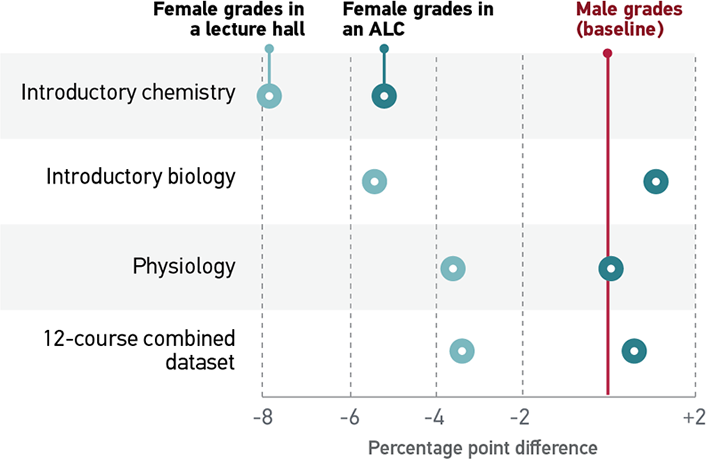Read about the impact of active learning classrooms (ALCs) on eliminating the gender penalty in STEM courses.

In 2018, for the second year in row, active learning classrooms (ALCs) are near the top of the list of most important strategic technologies for higher education. Part of the reason for this is that research has demonstrated that ALCs work. A series of studies conducted over the past decade at different institutions of higher education indicate that the type of classroom a course is taught in (a traditional lecture hall versus a new, technology enhanced ALC, for instance) matters to the student learning experience — to students' engagement, to their perceptions of the course, to the learning outcomes that they achieve.1
Female students suffer from a "gender penalty" in large, introductory science classes, meaning that women underperform in these courses compared to men, even when male and female students have similar scholastic aptitude and academic records.2 This dynamic results in lower grades for women in these early courses, which may contribute to the barriers that female students face as they attempt to enter and excel in STEM fields. Strategies and techniques are therefore needed to break the cycle that prevents women from identifying as competent scientists or engineers and increase their retention and advancement in STEM fields.
Data gathered at the University of Minnesota over the course of several semesters provide preliminary indications that teaching science courses in ALCs may mitigate the gender penalty. A retrospective analysis of four separate data sets from studies comparing classes taught in lecture halls with classes taught in ALCs showed a sharp reduction or outright elimination of the gender penalty in the ALC class (see figure 1).

These data were not collected as part of a systematic study designed to examine the interaction of gender and type of learning space, so the conclusions that can legitimately be drawn are limited. Taken together, however, they do form a conspicuous pattern — female students perform as well as their previous academic records would suggest when they are taking a course in an ALC, but not when the course is held in a traditional room. These data suggest that a possible benefit of ALCs is that they begin to erase the gender penalty for women in large introductory science courses. If future research in this area is consistent with these early findings, ALCs may form one important part of efforts to help women persist and succeed in STEM majors and careers.
Notes
- Paul Baepler, J.D. Walker, D. Christopher Brooks, Kem Saichaie, and Christina I. Petersen, A Guide to Teaching in the Active Learning Classroom: History, Research, and Practice, foreword by Bradley A. Cohen, (Sterling, Virginia: Stylus, 2016), pp. 9-37.↩
- Benjamin P. Koester, Galina Grom, and Timothy A. McKay, Patterns of Gendered Performance Difference in Introductory STEM Courses, (2016); 1–9.↩
- Data reported in figure 1 are the differences in average grade percentages between men and women. Positive values indicate female students perform better than male students; negative values indicate male students perform better than female students.↩
J.D. Walker is Research Associate in the Center for Educational Innovation at the University of Minnesota.
Paul Baepler is Research Associate in the Center for Educational Innovation at the University of Minnesota.
© 2018 J.D. Walker and Paul Baepler. The text of this work is licensed under a Creative Commons BY-NC-SA 4.0 International License.
